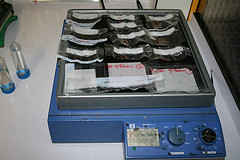3 Hot Tips to Optimize Your Western Blot Transfers
Are you struggling with ugly and unreadable western blots? Here are 3 ways to optimize your western blot transfer and get blots to be proud of.
Join Us
Sign up for our feature-packed newsletter today to ensure you get the latest expert help and advice to level up your lab work.

Are you struggling with ugly and unreadable western blots? Here are 3 ways to optimize your western blot transfer and get blots to be proud of.

Are your plasmid preps giving your poor yields? We’ve got 11 reasons that might be causing it and how to fix them.

As is sadly the case in many experiments, site-directed mutagenesis (SDM) does not always work the way we would like it to the first time around. Here are a few tips to help you on your way when trying to troubleshoot a bothersome SDM reaction!

The Phobia of RNases My first experience of troubleshooting in vitro transcription came when I was synthesizing RNA In-Situ Probes for the first time. A lab mate ominously warned me that I had just returned to lab after a bout of flu and that meant I’m a walking talking factory of RNases. I went ahead…

It’s Sunday morning, the sun has just begun to rise, and you find yourself on the way to the lab (again!), sipping hot coffee and melancholically thinking of your abandoned bed. But something is different this time. Today, the freezing-cold wind blowing from behind is not the only motivation pushing you to sacrifice another weekend in…

The first time I did a transformation was when I worked with site directed mutagenesis. I cloned a protein sequence into the p15TVL vector, created my mutants (but that’s another story), and was finally ready for the next step: transformation and expression of my desired protein. Little did I know that my enthusiasm would fall…

Flow cytometry is fast evolving from a method only revered by immunologists, to one used by nearly every biological specialty. It’s pretty much my favorite tool. Unfortunately, as with most lab techniques, much of flow cytometry is taught on the job without a lot of standards. And too often bad habits are passed along like…

Bubbles isn’t just the name of my favorite cartoon character from Power Puff girls, or just the best activity for a kid to play with, in general. In my adult world, they stand for a whole lot more, but can still cause extreme emotions. At the lab bench, seeing bubbles brings happiness or sadness depending…

Cryosectioning is difficult when your tissues melt, fold, curl, wrinkle, tear, or crack. Learn how to troubleshoot these pesky cryosectioning problems.

One of my favorite things about being a biochemist is to imagine everything at the molecular level—sometimes, in very corny ways. I envision the proteins I pipet and mix as dynamic characters in a molecular soap opera that intermingle with each other in complex ways. The biomolecular characters in my soap opera interact and react,…

Routine PCR? Let’s be honest, there’s no such thing. Even with the simplest PCR reaction things can go wrong, so you need to have a good checklist of ideas for PCR troubleshooting and rectifying the problem. Today I have brainstormed all of the ways I can think of to approach problems with standard PCR reactions….

The whole TLC technique sounds easy to do, but it can be difficult and tricky during interpretation or give unexpected results, especially when working with biomolecules. For this reason, it is important to be familiar with troubleshooting thin layer chromatography. Some of the common problems faced during TLC and their solutions are listed below: Solvent…
What is a luciferase assay and what is it useful for? A luciferase assay takes advantage of the innate bioluminescent properties some organisms exhibit, most notably the firefly. The firefly can convert luciferin to oxyluciferin in the presence of the enzyme luciferase to emit light. The most common scientific assays utilizing luciferase are reporter assays…
It’s happened to us all, you are ready to run your samples on the cytometer and you can’t see your cells on the screen. Here are a few tricks to troubleshooting this: Cytometer vs. computer connection The different types of cytometers will need different orders for switching on the cytometer and computer. Some are cytometer…

Using fluorescent proteins as imaging probes is a widespread and versatile technique in microscopy. You can use them in a wide range of living systems, from single cultured cells to complete organisms and animals. Fluorescently tagged proteins can be used to track and examine real-time localization, interactions, and translocation of your protein of interest, as…

Ever had a blot so bad it looked like a Rorschach test? We have ten things that might be going wrong with your western blots and how to fix them.

So, you’ve just received a call from the core facility that you hired to prepare and sequence your libraries. The facility director tells you that the sequence data from your next generation sequencing (NGS) experiment does not look good. You panic and, perhaps, let loose a scream of frustration—aaarrrrggghhhh! This project was going to be…

The eBook with top tips from our Researcher community.